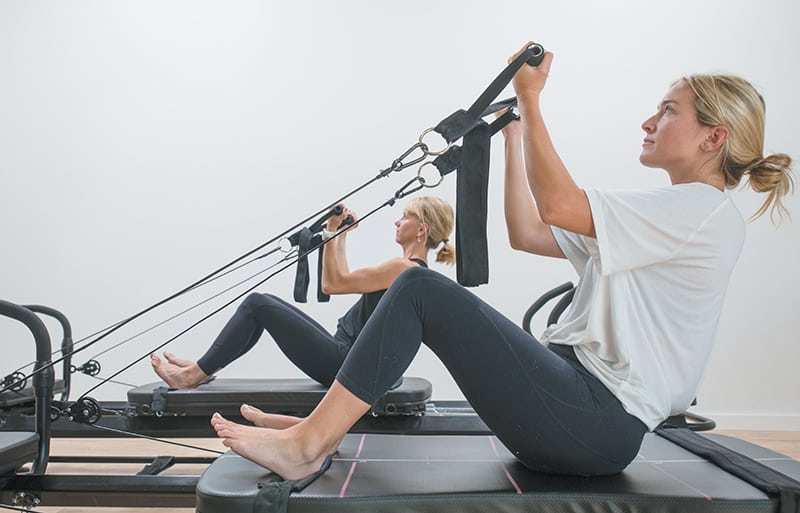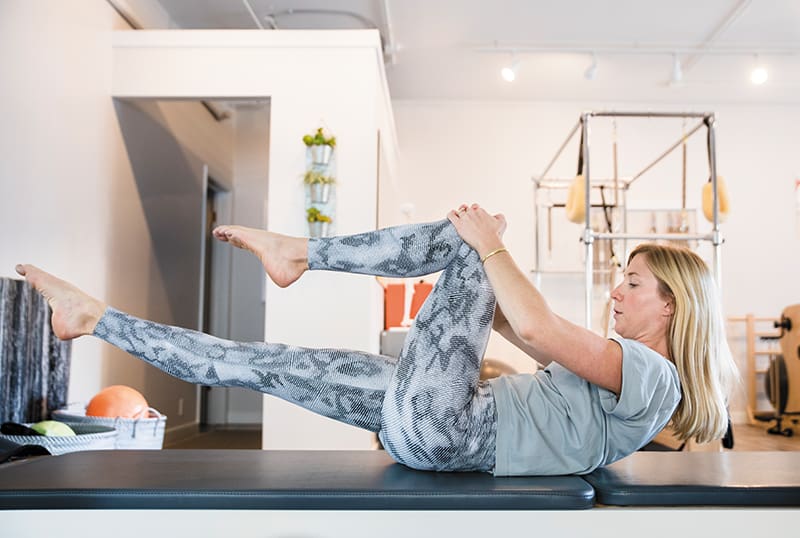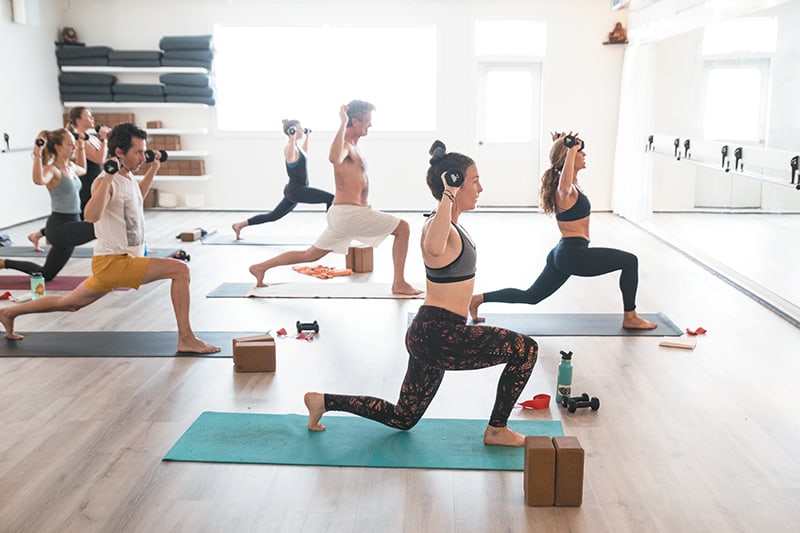Read The
Current Issue
More to the Core
Core strength training is an essential ingredient to keeping mountain athletes flexible and injury-free.
By Julie Fustanio Kling // photography by KATHRYN ZIESIG

Lizzie Johnson (left) and Bea Tufo (right) work with Pursue Movement Studio’s Megaformer machines.
SKIING IS HARD—especially here in Jackson Hole!—and it is hard on the body. Jackson Hole locals and visitors alike know this. What they might not know is how important core strength, balance, and flexibility are to being the best skier they can be and how they can help prevent ski injuries. There may be no official studies that prove this, but most every local has an anecdotal tale about how they could have prevented a torn ACL, aggravated back, or pulled muscle if they had had a stronger core and/or greater flexibility.
World Champion Big Mountain skier Crystal Wright opened Wright Training, which specializes in ski fitness, after a season-ending injury. “So many injuries can be prevented if you fix body mechanics, strengthen your core, and increase flexibility,” she says. “I had to learn the hard way through being debilitated from my back and knees.”
While research on core strength versus injury rates is lacking, there is research showing that core muscles stabilize the spine and improve the power of your limb movement, which may indirectly reduce lower
extremity injuries.
CORE
NIKI SUE MUELLER, a big mountain skier, yogi, and ambassador for Head Skis, has taught flexibility through yoga for 20 years. She recently added specific core strength exercises to her classes at Inversion Yoga.
“Core is so important for the sports we do in Jackson Hole,” she says.
In addition to yoga, Mueller teaches sculpt classes (also at Inversion Yoga). Sculpt weaves in fitness trends like “Tabatas,” four-minute periods of high-intensity interval training. For 20 seconds, you row, pedal, jump, or do any other activity that raises your heart rate; you then rest for 10 seconds. A traditional Tabata, which was “invented” by Japanese scientist Dr. Izumi Tabata and a team of researchers from Tokyo’s National Institute of Fitness and Sports, encompasses eight rounds of these 20/10 sets.
Align Pilates owner Laura Modena believes legs are central to core-strength training, as nonobvious as it may seem. “People feel much more than abdominal strength in Pilates,” she says. “We are doing foot work, hip work, and a lot more to get people to feel their abdominals.”
CORE EXERCISE
Align Pilates’ Modified Chest Lift
Modena says this will challenge your neck flexors and get rid of a relatively new phenomenon called “Text Neck”
• Lie on your back with your feet flat on the ground.
• Rest your palms down at the side of your body.
• Hover your head as if you are sliding a piece of paper underneath it to encourage your neck to engage.
• Roll up bringing your chest to your ribs, ribs to belly, and sliding your hands gently toward your feet without putting any pressure down on the ground.
BALANCE
RECRUITING YOUR CORE is as important to balance as eyesight and nutrition are, says Scott “Smitty” Smith of One to One Wellness. Like dance teachers who tell their students to pick one spot to look at as they twirl so they don’t get dizzy, Smith has clients focus their gaze as he encourages active isolation, or quick movements, to force them to release one muscle to engage another. “I’m not into the 20-second hold,” he says. “I’m into the 2-second hold so that you are getting a lot of movement when you stretch.”
With quicker movements, it is easier to flush the muscles of metabolic waste and bring in electrolytes and fluids from a good diet, Smith says. Nutrition supports the cells in active muscles but it’s hard for that nutrition to be absorbed by tight muscles. By doing active isolated stretching (AIS), he says, “You physically pull your leg with a rope so you can send a signal to the quads to release the hamstrings and support the cells in your active muscles.”
BALANCE EXERCISE
Toe Taps and Leg Lifts
Smith says these will challenge your hip flexors and lower abs
• Lie on your back.
• Place your arms straight down at your sides, palms on
the floor.
• Make sure your sacrum is anchored and your ribs, but not your lower back, are grounded.
• Levitate your lower back with a slight tilt of your pelvis.
• Bring one leg up so your femur is vertical and your knee is bent at a 90-degree angle; your shin will be parallel with the floor.
• Bring your second leg to join the first (this position is called “table top”).
• While keeping the 90-degree bend in your knee and engaging your core (without changing the position of your pelvis), lower one set of toes to the floor.
• Alternate feet, doing 10 taps with each.
FLEXIBILITY
THE MONKEY-SEE-monkey-do approach to flexibility is a trigger for a lot of fitness fanatics. If you don’t have the stability to extend a posture, you will deprive your joints of blood supply and nutrients, strain your muscles, and cause them to tire more easily, according to sports medicine experts at the University of California, Davis. This is why stretching is so beneficial. Stretching increases the mobility of soft tissue (that can restrict flexibility), improve circulation, and enhance performance by allowing muscles to return to a resting state. Flexibility also lengthens your muscles so that you take pressure off the tendons that connect muscles to bones.
The Barre Method isolates muscles with repetitions, some of which use light weights, at a ballet bar. Megaformer classes use slow movements on an apparatus designed to challenge your balance. Pursue Movement Studio offers both Barre and Megaformer classes and Jen Thorne, a Pursue instructor, says both are designed to lengthen and strengthen muscles, and are also effective at improving stamina. “Athletes have told us how strong they feel when they get out in the mountains after training with us—they can really keep up,” she says.
FLEXIBILITY EXERCISE
Modified Bird Dog
Thorne says this will challenge your internal and external obliques
• Start on your hands and knees; hold your head higher than shoulders.
• Make sure your spine is neutral (as if your back is against the wall).
• Slide one leg behind you, either keeping your toes on the floor or with the leg parallel to the ground.
• Push this leg behind you with energy as if you’re pushing away an imaginary wall, while maintaining a neutral spine and pelvis.
• Alternate between one leg and the other, doing about 10 “pushes” with each leg.



What is your “core” really??
Ask the trainers at 22 Gym how they define “core” and they’ll give you a dissertation. Health coach Pete Wilson, who teaches CrossFit classes, drew a diagram of a cube and explained where the six muscle groups are in 3D: The diaphragm is at the top, the pelvic floor at the bottom, the internal and external obliques on the sides, the quadratus lumborum at the back, and the rectus abdominis in front. “The core is circumferential,” he says. “When the cube is bomber, the back is protected.”
Physical therapist and Medicine Wheel Wellness owner Francine Bartlett thinks of the core as more than the central channel between the pelvic floor and throat. As she explains it, the core extends from the shoulder and hip joints to each of the four limbs. “It’s like an apple,” she says; “you set it down and it stands tall because you’ve left a little flesh on either side of the core.”
Butt Don’t Forget About Your Hamstrings
Augustine “Augie”Hernandez, who opened Training to be Balanced in 2005, often considers the gluteus maximus a part of the core. The glutes are the strongest muscles per cross sectional area (thickness) in the entire body, he says. When the core is not working, the lower back and the hamstrings are forced do the job of the glutes.
Weak glutes can make us compensate with our quads. That’s why in the spring, as athletes shift from winter sports like skiing and snowboarding to running and climbing, Hernandez adjusts class workouts to encourage strengthening of the glutes and extension of the hamstrings. “Runners often get back pain because their core can’t maintain stability when they run for the first time in the season,” he says. “Jackson is a linear endurance community. We spend a lot of time hunched over in sports and then we spend eight hours hunched over a computer.” JH




